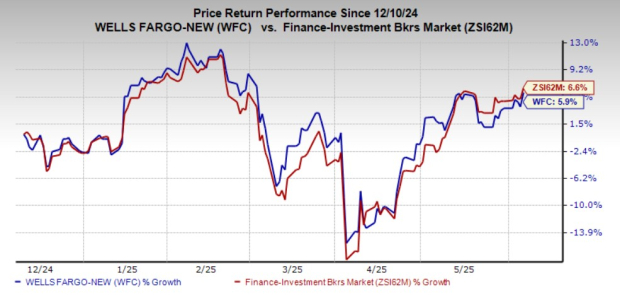|
|
|

|
|||||

|
|
S&P Global Ratings has revised the outlook of Wells Fargo & Co. WFC and its finance subsidiary, Wells Fargo Finance LLC, to positive from stable. The company's long-term issuer credit rating has been affirmed at ‘BBB+’ for both the holding and subsidiary companies. Also, the short-term issuer credit rating for the company has been affirmed at ‘A-2’.
Additionally, S&P Global affirmed long and short-term issuer credit ratings for several core operating subsidiaries, with a stable outlook.
This upgrade reflects S&P Global’s view that WFC has improved significantly in terms of governance, risk and control profile, enabling the removal of the Federal Reserve’s $1.95 trillion asset cap last week.
The asset cap was imposed in 2018 as WFC was accused of inflating its growth by forcing employees to create millions of unauthorized accounts to achieve sales targets.
The company has met key regulatory conditions, including board effectiveness and operational risk management, confirmed by a third-party review. Since 2019, Wells Fargo has terminated 13 consent orders, with only one remaining. It has also improved its financial crimes and anti-money laundering controls through a formal agreement with the Office of the Comptroller of the Currency last year. These efforts, backed by more than $2.5 billion in expenses and 10,000 risk-related personnel hiring, signal substantial progress in strengthening internal controls.
Enhanced Competitive Strength: The asset cap removal offers Wells Fargo a greater scope to compete for new businesses and deposits, without any material change in strategy or risk appetite.
Moreover, management does not indicate any planned changes except improvement in the business margins. Also, S&P Global anticipates an expansion of WFC’s commercial and investment banking business, units most impacted by the asset cap.
The rating agency expects the lifting of the asset cap and several consent orders would allow the company to redirect its spending toward the growth of fee-generating business instead of regulatory remediation efforts.
Higher Profitability & Stable Core Customer Base: The rating agency estimates that Wells Fargo’s adjusted pre-provision net revenues (PPNR) grew from $23.5 billion in 2022 to roughly $30 billion in 2024. Strong net interest income, fee income growth, alongside prudent expense management, drove the growth. The company has also moved away from non-core businesses over the years by divesting, downsizing or curtailing them.
These factors, in combination, allowed WFC to achieve a 13.4% return on tangible common equity in 2024, moving toward its target of 15%. Further, the company’s risk-adjusted profitability has improved. Its ratio of pre-tax income to regulatory risk-weighted assets (whether measured using the standardized or advanced approach) grew last year to one of its highest levels since 2018.
Well-Positioned to Handle Potential Economic Shocks: Wells Fargo benefits from the scale of a universal bank while having a simpler business model, similar to that of a large regional bank, with well-diversified revenues and no significant concentration risks.
Although its commercial real estate loan exposure is higher than peers’ (14.7% of total loans as of March 31, 2025), the bank has adequate reserves to tackle potential losses. The company’s strong PPNR should provide a buffer when credit loss provisions need to increase, if the U.S. economy weakens.
The bank’s balance sheet remains healthy, with a common equity Tier 1 ratio consistently above 11 over the past year. Its deposit base has stabilized and is likely to grow further given the removal of the asset cap. Liquidity also remains steady, with an average liquidity coverage ratio of 125 in the first quarter of 2025.
The positive outlook reflects S&P Global’s expectation that Wells Fargo will improve profitability while maintaining strong asset quality and solid capital position. Further, the removal of the asset cap reflects an improved internal control and governance structure, enabling higher business and deposit growth.
Despite the holding company having a positive outlook, the outlook for core operating subsidiaries remains stable as their ratings already incorporate a two-notch increase above its stand-alone credit profile. This is due to the company's additional loss-absorbing capacity, which supports the operating companies but not the holding company.
Over the past six months, shares of WFC have risen 5.9% compared with the industry’s growth of 6.6%.

Currently, WFC carries a Zacks Rank #3 (Hold). You can see the complete list of today's Zacks #1 Rank (Strong Buy) stocks here.
Last month, Fitch Ratings revised the outlook of UBS Group AG UBS, UBS AG and UBS Switzerland AG to positive from stable. UBS' long-term Issuer Default Rating has been affirmed at 'A,' while UBS AG and UBS Switzerland AG have been affirmed at 'A+.’
This upgrade reflects Fitch’s expectation that UBS Group’s well-advanced integration of Credit Suisse will continue to reduce execution risks while improving profitability.
In March 2025, Hercules Capital, Inc. HTGC announced that Morningstar DBRS has upgraded its investment grade credit and corporate ratings to BBB (high) from BBB. Further, the trend revision has been revised from positive to stable.
The upgraded ratings with a stable outlook indicate HTGC’s sustained solid operating performance in 2024 and a roughly 14% rise in assets under management on a year-over-year basis.
Want the latest recommendations from Zacks Investment Research? Today, you can download 7 Best Stocks for the Next 30 Days. Click to get this free report
This article originally published on Zacks Investment Research (zacks.com).
| Dec-20 | |
| Dec-20 | |
| Dec-19 | |
| Dec-19 | |
| Dec-19 | |
| Dec-19 | |
| Dec-19 | |
| Dec-19 | |
| Dec-19 | |
| Dec-19 | |
| Dec-19 | |
| Dec-19 | |
| Dec-18 | |
| Dec-18 | |
| Dec-18 |
Join thousands of traders who make more informed decisions with our premium features. Real-time quotes, advanced visualizations, backtesting, and much more.
Learn more about FINVIZ*Elite